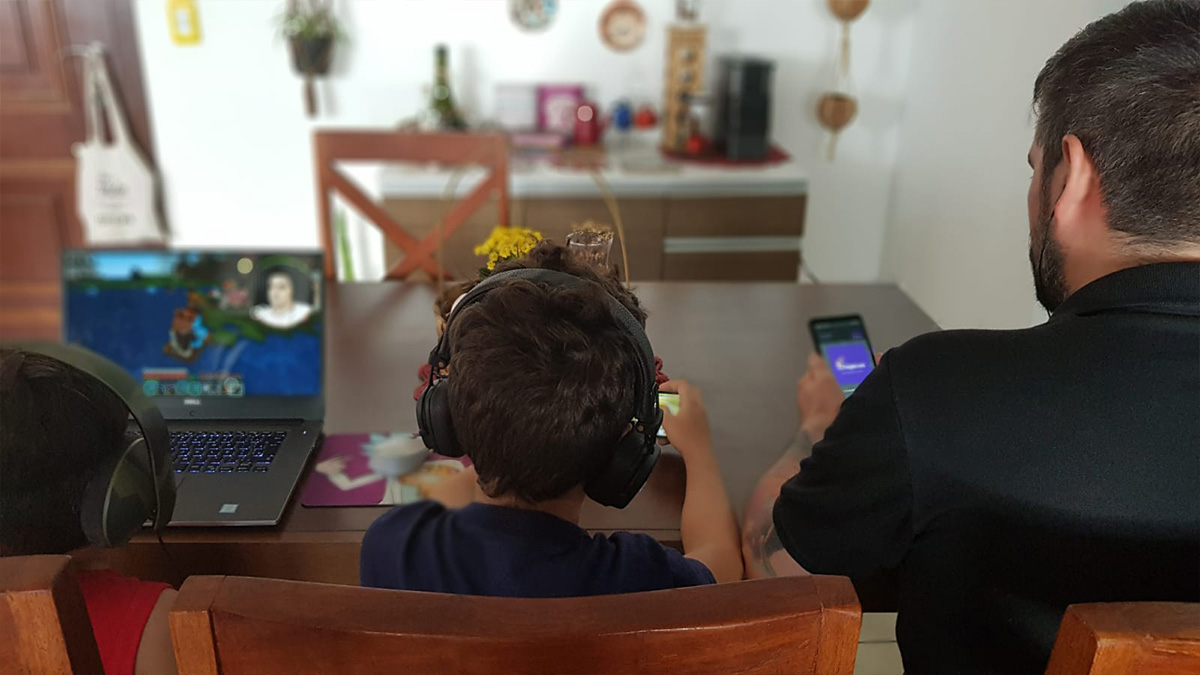
Renata Moura
Journalist
Davi wakes up every day around 6:30 am, has breakfast, grabs his notebook, books, computer and headphones. “I use the headphones to study, listen to music and play,” says the 9-year-old boy. On the virtual platform that started to bring together school activities – after the suspension of face-to-face classes due to the new coronavirus – he is instructed to watch part of the video content and to be ready at 9 am, for the class's video conference with the teacher. The grandmother has the radio on while cooking, the younger brother watches TV in the living room and the mother works sewing in another room.
A few kilometers away, Ricky, a 35-year-old teacher and the child's uncle, is also wearing headphones. “I feel more focused because I listen to podcasts or music while doing other things at home. I also use it to have more immersive experiences playing video games and, one of the main factors: so as not to disturb my wife, who is working from home during this period.”
The two people from Natal illustrate changes in behavior in the consumption of audio and videos recorded during the quarantine – as well as the trend towards greater use of headphones in Latin America, identified in a recent report by the American consultancy Arizton, with projections for the market in the period from 2020 to 2025.
For users of this type of accessory, a warning comes, however, from research, health authorities and preceptors and students of the Multiprofessional Residency in Health Care for Persons with Disabilities offered by Center for Health Education and Research Anita Garibaldi, from the Santos Dumont Institute (ISD): Possible inappropriate use brings risks.
Using information from the World Health Organization (WHO), studies and online guides, the team draws attention to the danger of incorrect and prolonged exposure to intense sounds, the possibility of infections with possible shared use and, also, the importance of hygiene practices, teaching how to properly clean wires, removable parts and other external areas.
Click here to access the video on the ISD YouTube channel or press play below to watch:
Fungi and bacteria
A study published in 2017 by biomedicine faculty at Devry Metrocamp, in Campinas (SP), gives clues as to why this type of care is important. The study identified up to 10 thousand fungi and bacteria in headphones that were normally borrowed and that were not usually cleaned. In interviews with news portals at the time, the researchers involved stressed that contamination can cause everything from itching and ringworm to meningitis and hearing loss.
Last year, the WHO reinforced the chorus, highlighting that approximately half of the population aged between 12 and 35 years old – a group made up of 1.1 billion young people – is at risk of hearing loss due to prolonged use and excessive exposure to loud sounds, including music they listen to on devices personal audio files.
Ricky, the professor mentioned at the beginning of the text, says he is aware of the issue. “I know that prolonged use at high volumes causes damage and I imagine that if I spend a lot of time with stuffy ears it could lead to infections. So I try not to do that. I also don’t lend them and clean them with isopropyl alcohol,” he says. Davi, a user of the internet and online games under the supervision of adults in the family, also states that cleaning the accessory is a habit and that he does not share headphones even with his brother, Fabrizio. The youngest uses his own device.
Uncle and nephew agree that routine precautions are essential, especially now, when they both admit they are consuming audio and videos more than ever. They are among the battalion of users who, due to the isolation imposed by the pandemic, stopped traveling to school or work and, as a result, had changes in their schedules and activities in their daily lives.
A survey of the music streaming service Deezer, published in March, shows that instead of the usual 7am peak hour, the world now plays their favorite tracks between 9am and 10am – just like the people of Natal. The study also points out that Friday lost its leadership as the day of the week with the greatest reproduction of music and other content. “Now, for the first time, every day behaves the same.” Podcasts, playlists that help entertain children, do physical activities or that reflect the mood of the day have also become increasingly popular among the quarantined public, according to the platform.
Another trend was also highlighted in March in the report Earphones and headphones market – global outlook and forecast 2020-2025, with global perspectives from the American consultancy Arizton for the headphones market, and analyzes covering Brazil, Mexico, Chile, Argentina, Colombia and Peru, among other countries.
The analysis shows that with the increase in the number of mobile devices and internet access in Latin America, the region will become a leader in “online streaming” consumption – a universe that includes everything from platforms like Deezer and Spotify to channels like Netflix and Amazon, for example – and that the favorable scenario is likely to boost demand for headphones.”

Find out more: ISD against Covid-19 and disinformation
The video that warns about caution when using headphones is part of a larger set of educational actions that the Santos Dumont Institute, a Social Organization linked to the Ministry of Education, has developed during the pandemic. Through channels such as videos, booklets, folders and illustrations, teams show everything from how to identify Covid-19 symptoms to practical changes in day-to-day services, care to be adopted and integration and leisure activities for a healthy routine in times of Quarantine. The topics were discussed and materials have been developed in online meetings with multidisciplinary preceptors and residents from the areas of physiotherapy, speech therapy, psychology and social work, as well as professors and students of the Institute's master's degree in neuroengineering. The objective of the work, according to ISD, is to disseminate verified information and combat the spread of misinformation during this period. The Santos Dumont Institute encompasses the Edmond and Lily Safra International Institute of Neuroscience and the Anita Garibaldi Health Education and Research Center - a reference in physical, intellectual and auditory rehabilitation in Rio Grande do Norte.
Text: Renata Moura / Ascom – ISD
Photograph: Renata Moura / Ascom – ISD
Communication Office
comunicacao@isd.org.br
(84) 99416-1880
Santos Dumont Institute (ISD)
Social organization that maintains ties with the Ministry of Education (MEC) and whose mission is to promote education for life, forming citizens through integrated teaching, research and extension actions and to contribute to a fairer and more humane transformation of the Brazilian social reality.















